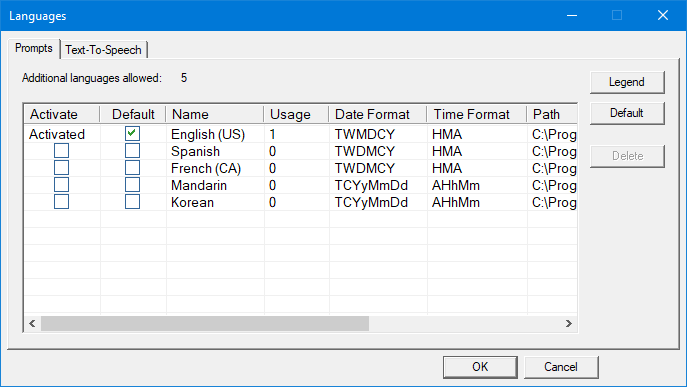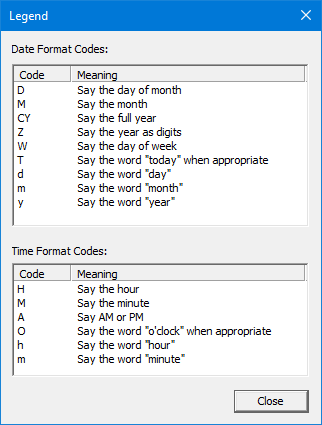Languages
Every DV2000 system ships with a set of voice prompts used to voice instructions, options and other information to callers, subscribers and administrators. More than one prompt set may be installed on the system to support alternative languages (such as Spanish) or language variants (such as British English instead of American English). By default, the system ships with American English as the default, and only, language.
By default, a system is licensed for a maximum of 5 languages: U.S. English plus any four other languages. However, only U.S. English is installed by default. Additional languages may be installed at additional cost; contact DuVoice Sales for more information on multiple language options.
Every mailbox has a language setting that specifies which language to use when a subscriber logs into the mailbox to retrieve messages. This setting does not determine the language used when a caller is leaving a message in the mailbox. It only determines the language used in the subscriber menus. By default, this value is set to Default, which means that the mailbox will use the global default language, whatever that may be. If it has been set to a specific language, then it will use that language regardless of the global default.
When you select Features | Language from the main menu, it will open the dialog shown below, which allows you to activate additional installed languages, change the global default language and change the date and time formats.

Every language installed on the system is listed in the table as shown above. This table contains the following information:
| Column | Description |
|---|---|
| Activate | Check this box to activate the language. Uncheck it to deactivate the language. You can only activate as many languages as your license allows. By default, you can have up to 4 languages in addition to U.S. English (which, as shown, is always activated). If an entry in the table is grayed-out, that means it cannot be activated because you already have the maximum number of languages activated that your license allows. In the dialog above, the language Italian cannot be activated because there are already 8 languages activated (besides U.S. English), the maximum licensed for this system. You cannot deactivate a language if it is marked as the default language, nor can you deactivate U.S. English. Additional language prompt sets may be installed, and therefore listed in this dialog, but you will not be able to activate more than the number licensed. |
| Default | Check this box to make the selected language the default language for the system. Only one language can be marked as default. Only an activated language can be selected as the default. Warning: Most supported languages only have prompts for the guest subscriber menu. Please refer to the Additional Languages section for a table showing which languages have full prompt sets and which only support the guest subscriber menu. |
| Name | The name of the language. May specify a two-character country identifier in parentheses after the name. Read-only. |
| Date Format | Enter the format string indicating how dates should be voiced in the given language. |
| Time Format | Enter the format string indicating how times should be voiced in the given language. |
Legend
Click the Legend button to open a dialog, shown below, that displays the valid formatting codes for the Date Format and Time Format settings.

Date Format
The date format string is a mask or code that tells the 7.00 how to speak a date, such as when stating when a message arrived. As shown in the figure above, the following characters may be used; any other character will be stripped from the string when you save it.
In the following table, the Example field gives the actual word(s) the system would say (in English) for the given format specifier, assuming a date of June 1, 2013.
| Code | Meaning | Example |
|---|---|---|
D | Say the day of month | “first” |
M | Say the month | “June” |
CY | Say the full year | “two thousand thirteen” |
Z | Say the full year, as digits | “two zero one three” |
W | Say the day of week | “Friday” |
T | Say the word “today” if date actually is today | “Today” |
d | Say the word “day” | “day” |
m | Say the word “month” | “month” |
y | Say the word “year” | “year” |
Time Format
The time format string is a mask or code that tells the 7.00 how to speak a time, such as the time a message arrived or the time of a scheduled wakeup call. As shown in the Legend dialog, above, the following characters may be used; any other characters will be stripped from the string when you save it.
In the following table, the Example field gives the actual word(s) the system would say (in English) for the given format specifier, assuming a time of 8:25 p.m. In the case of specifier O nothing will be said because the minute value is not zero.
| Code | Meaning | Example |
|---|---|---|
H | Say the hour | “eight” |
M | Say the minute | “twenty-five” |
A | Say “a.m.” or “p.m.” as appropriate | “p.m.” |
O | Say “o'clock” if relevant | “o'clock” |
h | Say the word “hour” | “hour” |
m | Say the word “minute” | “minute” |
Additional Languages Allowed
One language prompt set is provided by default, U.S. English, and up to four others may be installed and activated at no cost. Additional languages can only be activated if a license has been purchased that allows for more than five languages.
In the example dialog shown previously, the system was licensed for a maximum of 8 languages, in addition to U.S. English, but they have actually installed 9 languages. Therefore, one of the languages (Italian in this case) cannot be activated, and is therefore grayed-out. To enable Italian, the user would have to first deactivate one of the other 8 languages, or else purchase a license for the extra language.